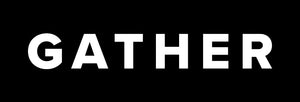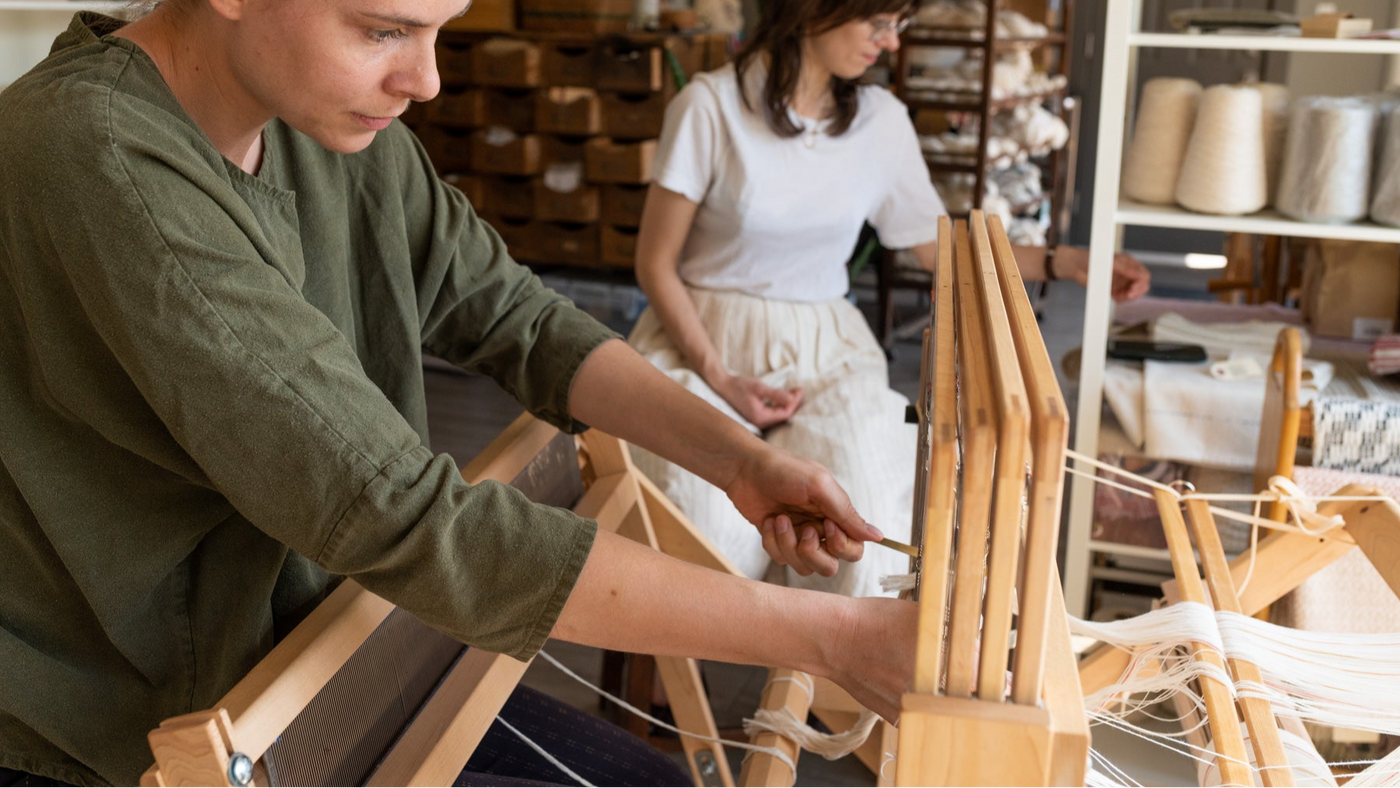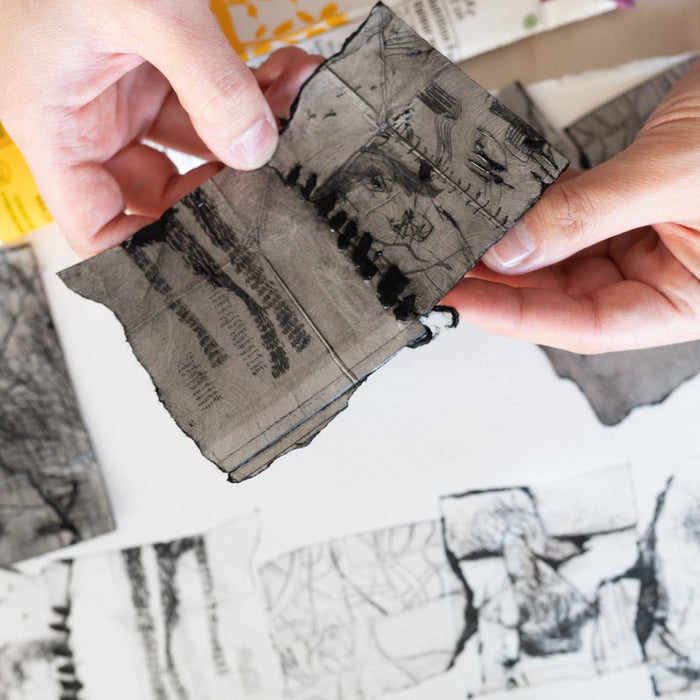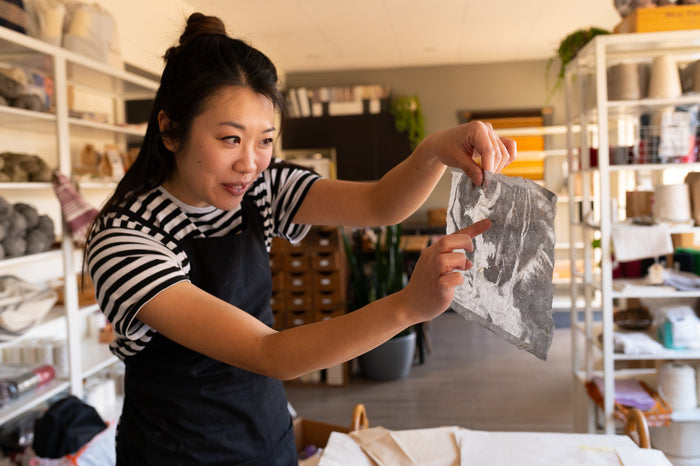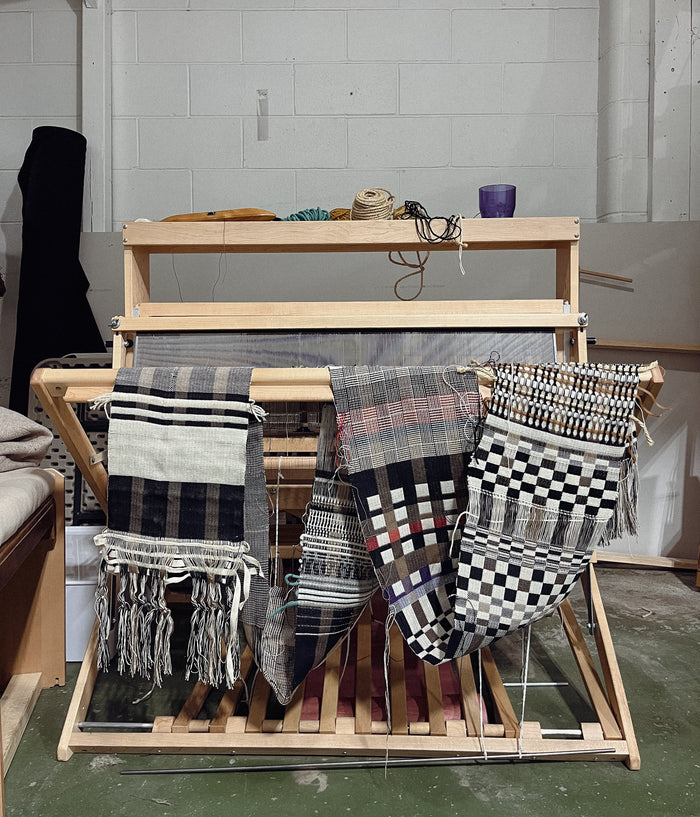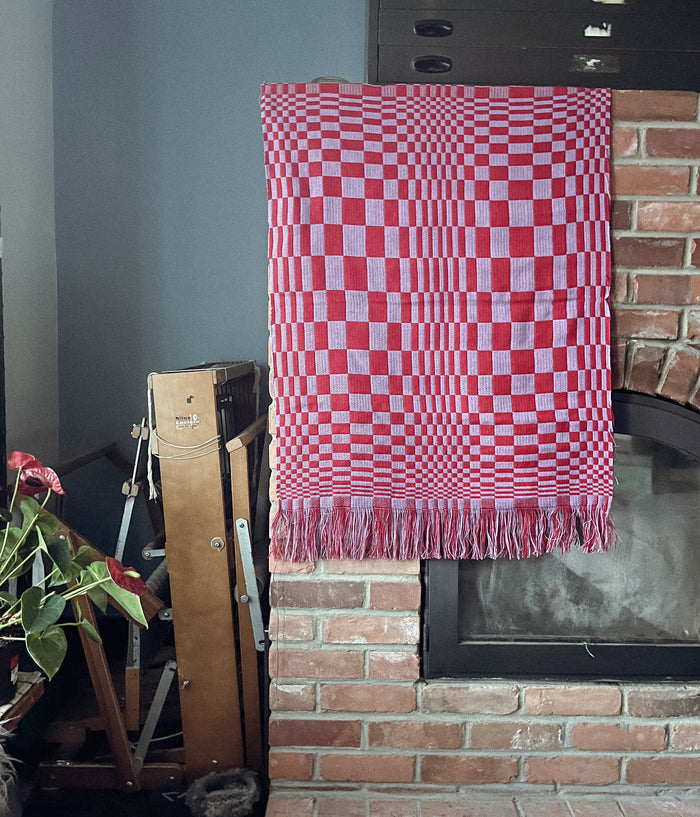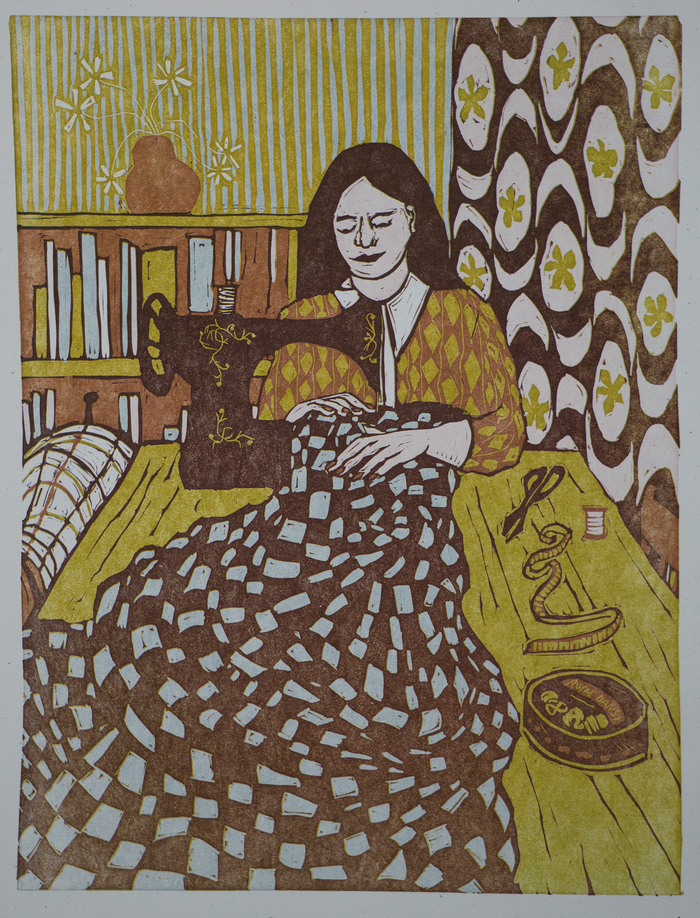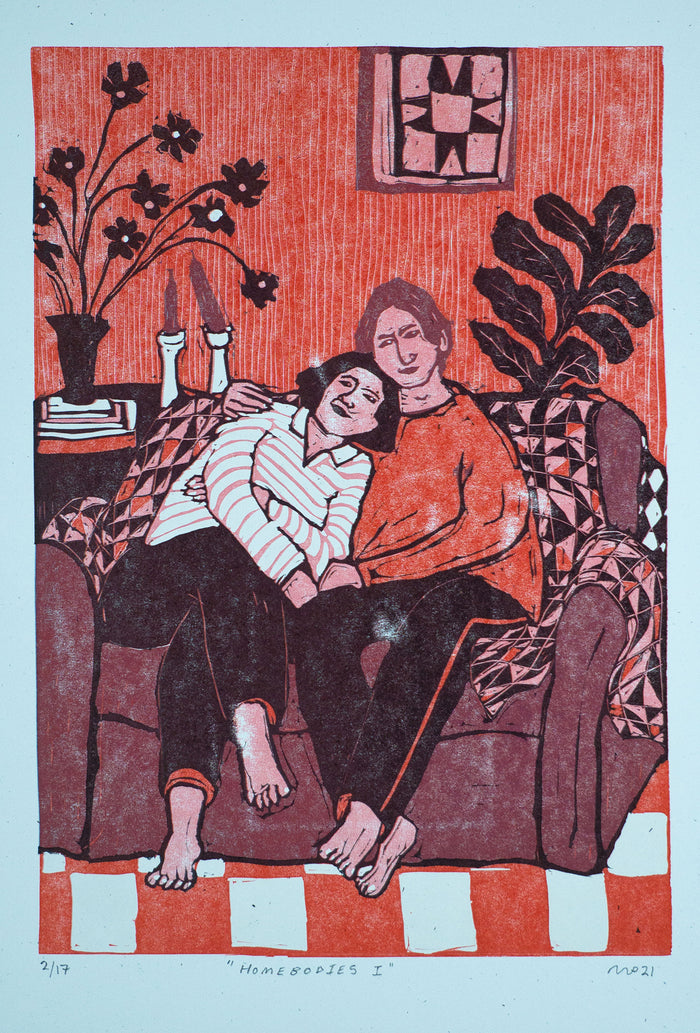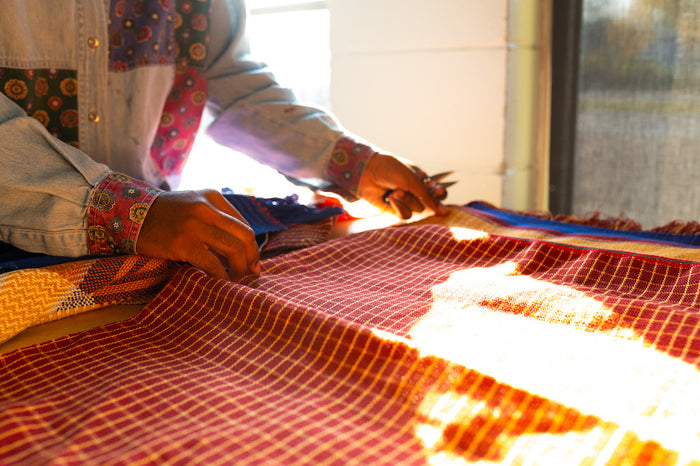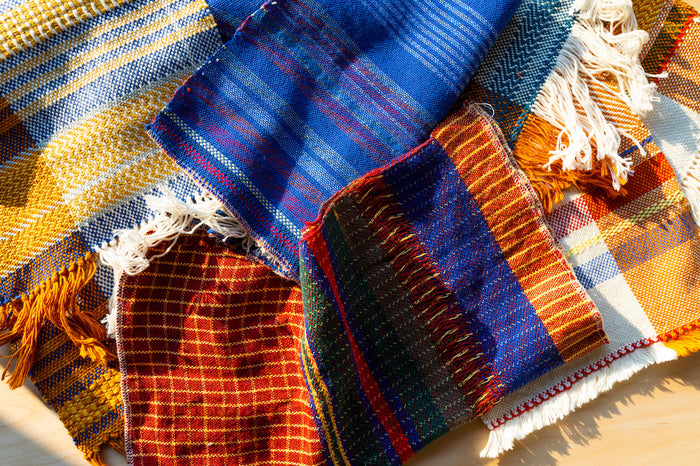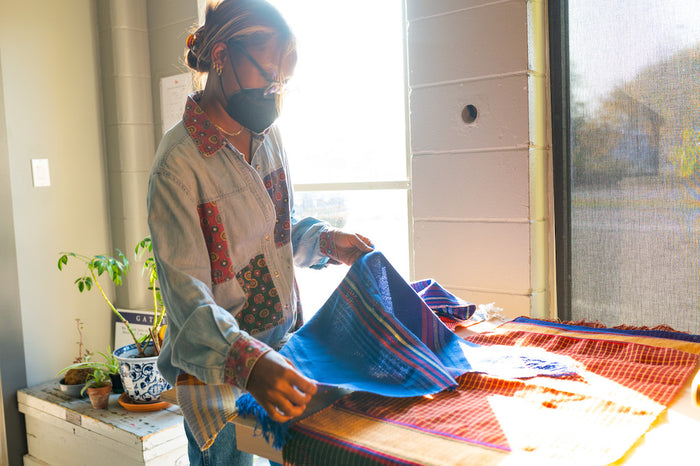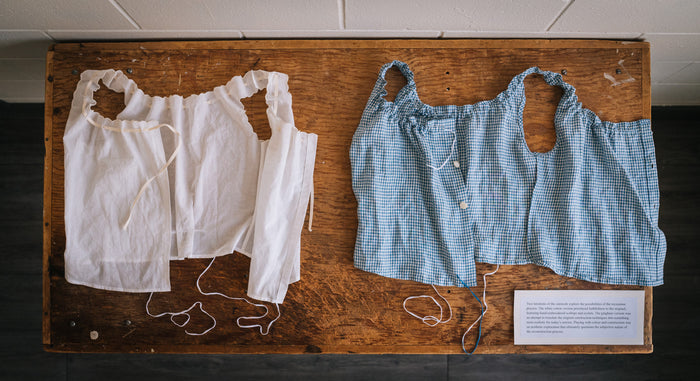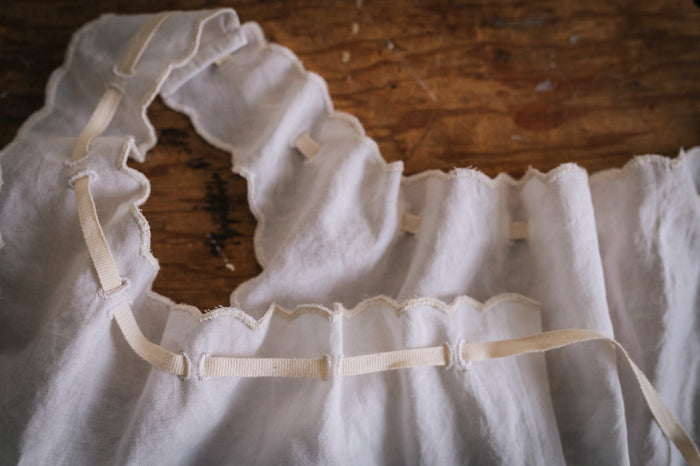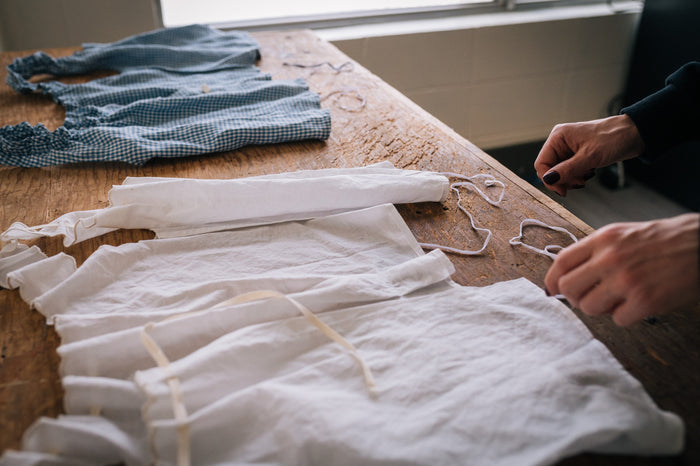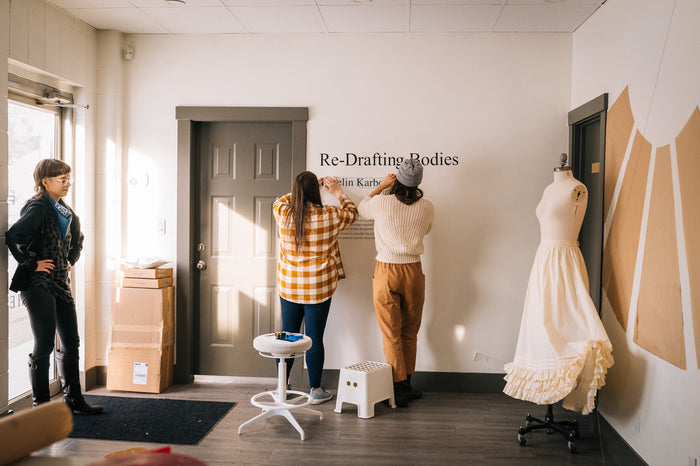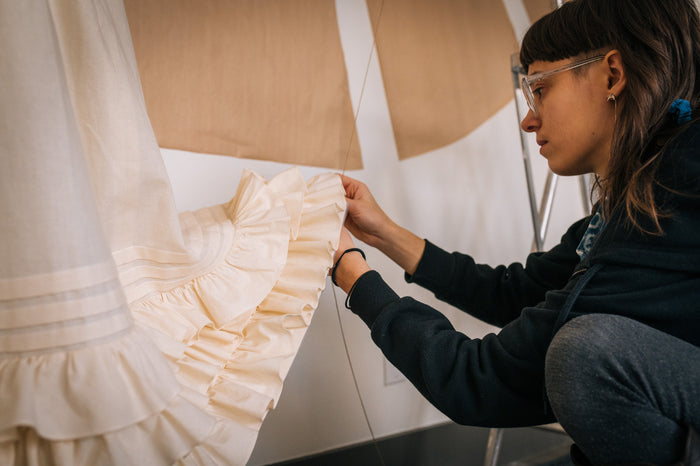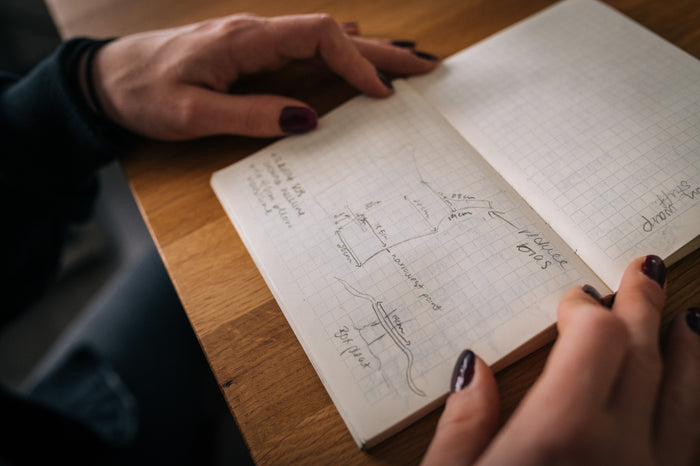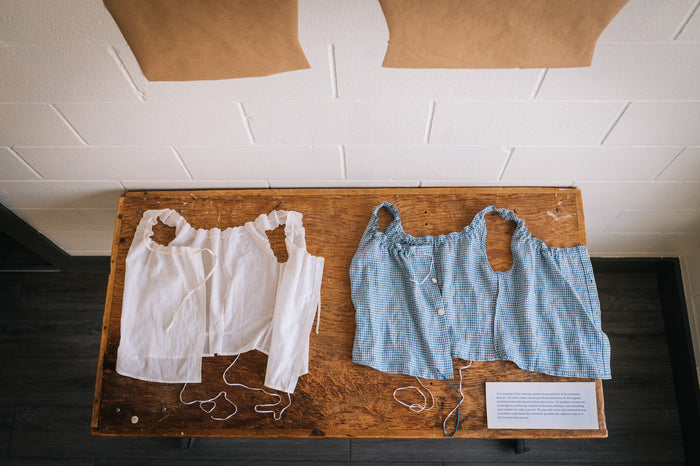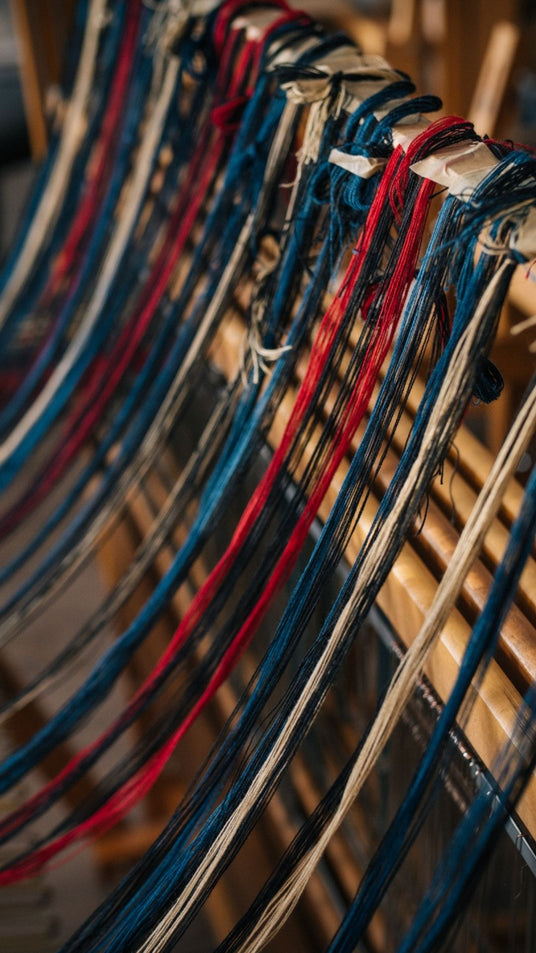
ABOUT
Gather Textiles Residency Program
Gather Textiles is located in Treaty 6 territory (Edmonton). This past year we have moved to a larger studio location where we now have the capacity to host artists biannually. Artists in residence are invited to use our studio space for a period of 1 - 3 months to research, learn a new technique, or create new work.
This residency is free of charge. The artist in residence is welcome to the following while residing with us:
- Free access to our studio materials wall (includes a variety of weaving materials for warp and weft)
- Access to equipment for their project which may include 8 shaft, 4 shaft or rigid heddle or frame loom, power punch needle equipment, access to our natural dye studio and dyeing equipment
- Free access to our online courses for 4 shaft and rigid heddle weaving-Free admission to our in person workshops (as available- some may require a materials cost)
- Technician support for equipment as required -Photography of process and work created (if desired)
- Promotion via our social media and email (if desired)
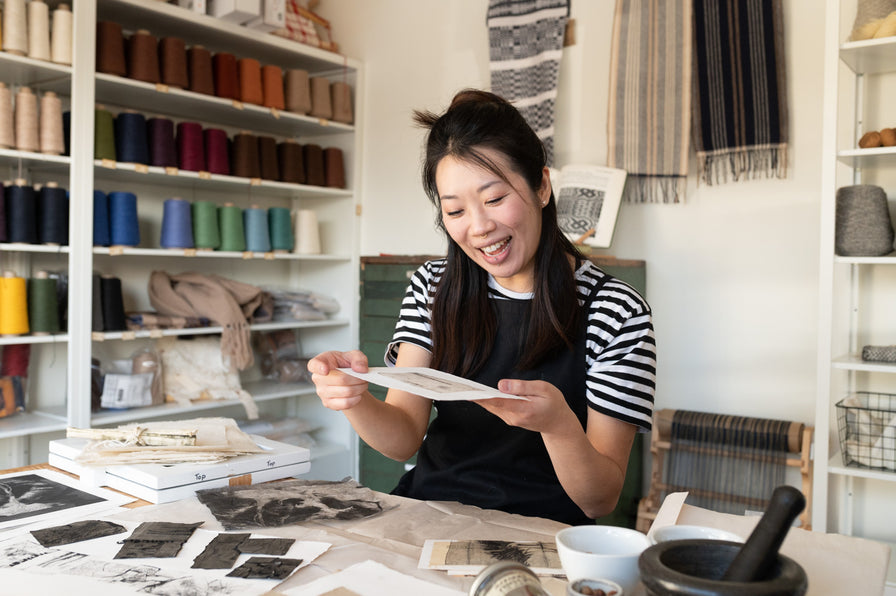
Christine Ha
Fall/Winter 2023
I am curious about the translation spaces between artistic creative practices and healthcare as away to create room to breathe in containment. I am a doctoral candidate in the Faculty of Rehabilitation Medicine at the University of Alberta. I draw on my artistic practice in printmaking as a way to create visual translations, expressions, and conversations from past and ongoing experiences in academic institutional spaces, as well as clinical healthcare learning spaces.
I use primarily materials destined for the landfill. I employ techniques such as tetrapak etching and collagraph as accessible modes for creating plates for printing, and create paper for printmaking out of waste materials such as fabric scraps. This work concerns itself with making room to breathe, and is firmly rooted in the haptic, feminist, and disability justice politics of bell hooks, Audre Lorde, Leah Lakshmi Piepzna-Samarasinha, and Mia Mingus as examples of writers who found ways to oxygenate even in the most oppressive institutional spaces. I am inspired by critical making, and socially engaged art as functional, political, and poetic.
My artist residency at Gather Textiles focused on experimenting with dyes created from kitchen waste, such as onion skins and avocado pits, and foraged plant materials. I had the opportunity to create dyes and printmaking inks for silk screening. I am curious to turn some of these dyes into pigments for suspension in burnt plate oil specifically for intaglio printmaking in the future. I am interested in relationality, both to our materials and process. Some of the questions that inform my work are about ways we can collectively create art, and creating together as ways to generate praxis in care.
I am also half of a collective that makes works and has conversations around interbeing and community.
www.axiologyclinic.com
I am a recipient of the Edmonton Artists’ Trust Fund Award. Supported by the Edmonton Arts Council and the Edmonton Community Foundation, this award is dedicated to the artistic development of Edmonton artists.
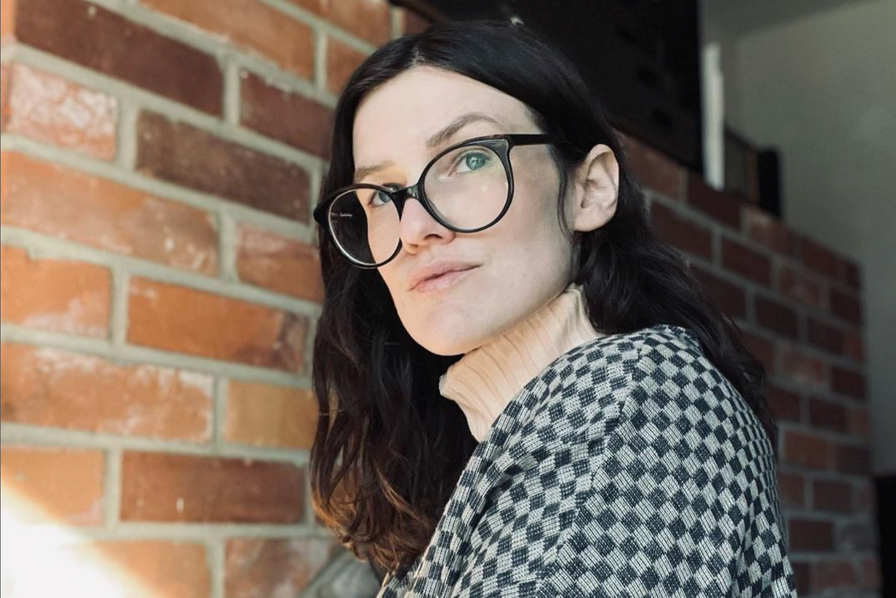
Morgan Pinnock
Winter 2022-2023
As an artist working primarily in printmaking, illustration, and recently photography, weaving has always been a peripheral interest, rather than an integral part of my practice. My goal during my residency at Gather was to integrate weaving into an existing body of work, while challenging myself to learn a new technique-- double weave.
I started out by familiarizing myself with the structure of double weave by completing the 4 and 8 shaft samplers from Jennifer Moore's book "Double Weave." Through this process, I discovered what techniques appealed to me and what I wanted to explore further during my residency. I was particularly drawn to the checkerboard pattern and its variations, which allowed for the most colour vibrancy, while also creating these fun little pockets and tubes within the structure..
In my first piece after the sampler, I experimented with making large pockets that I stuffed with discarded wool from the nearby skirting table. I could see this technique being used to create a garment, like a quilted vest! At this point in my residency, I was completely overwhelmed by the many possibilities that double weave presented, and I had to stop myself from making a pair of pants on the loom, no matter how impractical, just because I could!
In all of my work, I am drawn to textiles and the way that colour and pattern interact to convey emotion and meaning. For my final piece, I took inspiration from the complex and layered compositions of my printwork and reproduced them in a large wall hanging using checkerboard double weave. The result was a trippy, op art like weaving that incorporated new techniques and tactility into my art practice. I’m still figuring out where to take it from here (this isn’t a “finished” work in the photo), but I’m positive that the knowledge and experience I gained during my time at Gather will be a springboard for a new body of work.
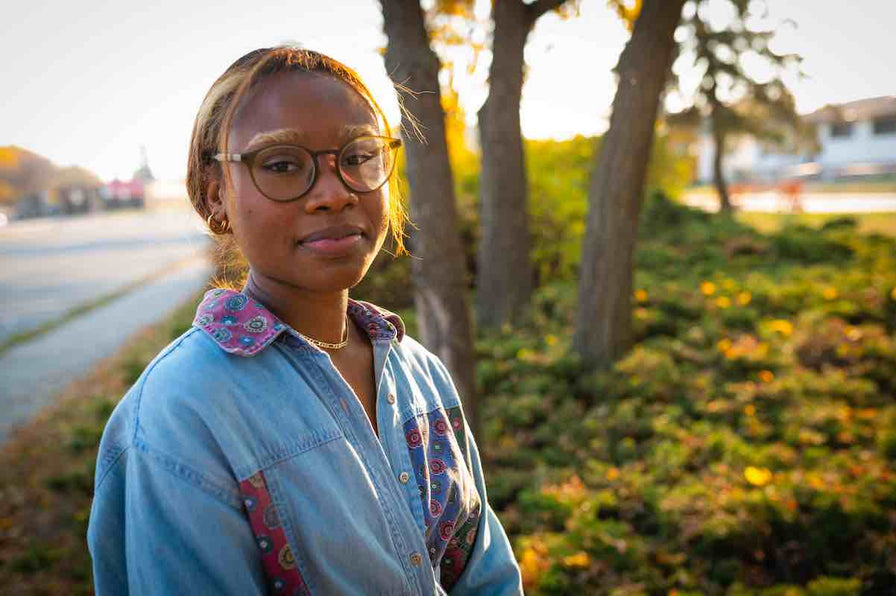
Raneece Buddan
Fall 2022
Prior to the residency, my art practice was primarily sculpting with clay and wood and doing mixed media oil paintings with a recent interest in making my own textiles. I began printmaking, screenprinting and block printing on hand-dyed fabric with the goal of eventually learning to weave.
My practice is focused on my cultural identity as a Jamaican woman of Afro and Indo-Caribbean ancestry. I show the beauty of merging these cultures as well as the complexities of not fitting the mould of “looking Indian” highlighting hair and skin tone, two major factors that affected my sense of belonging to this group as my hair was too thick and skin too dark. Textile has been used in my work to signify each culture sometimes replacing my skin tone.
My goal in entering this residency was to learn a new skill that I could later implement as a part of my practice. I wanted to learn how to make textiles that I could use in my paintings versus only purchasing them. By making them myself I am able to further my research and know more about their origins and how they are made.
I learnt how to weave linen and cotton on a four-shaft loom. I made three samples experimenting with combining the patterns of Okene cloth from Nigeria and Ilkal from India as self portraits of my mixed identity, as well as, two final samples and main pieces that were primarily one culture.
For my final two pieces as with the others, I was inspired by the patterns and techniques of multiple pieces of textiles that I combined into one. I replicated the stripes prominent in Okene textiles as well as the vibrant use of colour. The Okene cloth local name "Ita-Inochi" woven by the Ebira people of Central Nigeria. For my Indian textile I researched Ilkal from the Indian state and chose a check pattern for the body and a decorative border using the colours red, green and gold which are prominent colours throughout Indian culture.
These final pieces will be shown in my upcoming show Desiderium at The Southern Alberta Art Gallery from December 2 to February 12, 2023. I will be using the samples to create new work in the meantime.
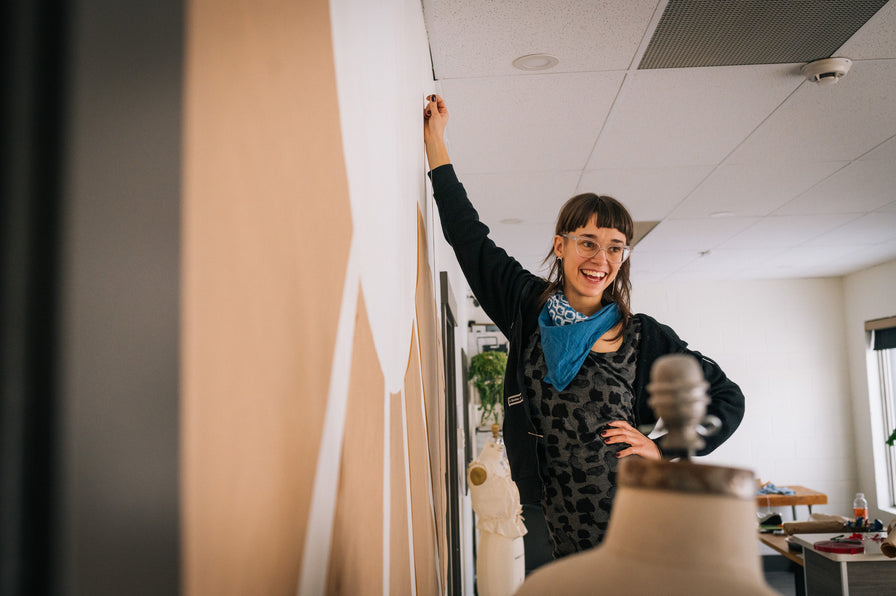
Katelin Karbonik
Winter 2021/2022
Re-Drafting Bodies
This exhibit features a series of patterns drawn from historic garments alongside their muslin recreations. Carefully measuring the original garments, drawing the patterns, and making the recreations served as a slow meditation on the forgotten labour and knowledge required to make clothing. By presenting patterns beside the garments they make, this exhibit invites viewers to consider the relationship between two-dimensional patterns and the three-dimensional bodies they cover.
Interested in Applying?
Applications are being accepted for spring/summer 2023 and fall/winter 2023. Submit your application via email with the subject line “Artist in Residence Application” at anytime.
Application Process
To apply, write us an email introducing yourself and a 2-3 sentence description of what you would like to do for your residency. If we determine your project is something Gather has the capacity to support we will ask for a 1000-3000 word project description that includes the work you will undertake, a timeline, what you will require from Gather in terms of space, materials, and education. Please also include how you will contribute to the community. Include up to 10 images and if applicable, website and/or social media.
We acknowledge that written submissions are not the best way of expression for all, so if you would prefer a conversation, video submission, phone call, visit or other type of communication, please be in touch via email and we’ll set that up!
Contributions to the community might include (but are certainly not limited to) an artists talk, showing of your work, workshop, volunteer time with a community volunteer agency, etc.
If you require assistance in securing funding or a grant to be away from your home place, don’t be shy to ask for help in setting that up.
If you will be applying for your own funding to reside, we will happily provide Letters of Support and any other resources and references you might need to do so.
